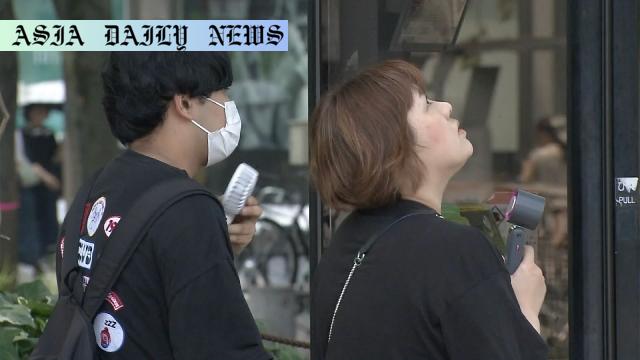Heatstroke: Japan braces for scorching temperatures above 35°C. Stay hydrated, use air conditioning, and avoid prolonged outdoor activity.
Heatstroke alert issued for various regions across Japan.
Temperatures expected to rise above 35°C in many regions.
Authorities recommend hydration, air conditioning, and rest.
Localized thunderstorms possible despite sunny weather.

Scorching Temperatures Across Japan
Japan is preparing for yet another day of extreme heat, with temperatures expected to soar above 35 degrees Celsius in several regions. The country’s Meteorological Agency has indicated that a high-pressure system will dominate the weather, bringing mostly sunny skies and intense heat. Cities such as Nagoya, Kyoto, and Kofu are forecasted to experience highs of around 37 degrees, while Hiroshima and Takamatsu will see temperatures of 36 degrees. Even Tokyo, the bustling capital city, will not be spared, with residents warned of highs reaching 35 degrees.
Smaller cities such as Osaka, Yamagata, Toyama, and Matsue are also expected to see the mercury rising into the low to mid-30s. This unrelenting heat not only challenges daily life but brings substantial health risks. The government has urged citizens to remain vigilant, particularly regarding the dangers of heatstroke in such conditions.
Heatstroke Alert Issued Across Multiple Prefectures
The issued heatstroke alert serves as a stark reminder for people to take adequate precautions. Prefectures such as Tokyo, Kanagawa, Aichi, Mie, and many others have been placed under the alert—marking the first time this season that Tokyo and Kanagawa received such a warning. Those living in the Kyushu region, excluding Kagoshima’s Amami islands, have also been advised to stay cautious.
To mitigate the risks associated with the heatwave, authorities recommend the use of air conditioners, frequent intake of water and salt, and avoiding prolonged exposure to outdoor heat, especially during peak hours. Workers engaged in outdoor jobs should take regular breaks to prevent heat-related illnesses. These measures, if followed diligently, can significantly reduce the chances of heatstroke.
Localized Thunderstorms Amid Rising Temperatures
While the high-pressure system provides sunny weather, there is a likelihood of unstable atmospheric conditions developing in certain areas. Weather officials have noted that localized thunderstorms could occur, particularly along the mountainous regions in western and eastern Japan. These storms may result in sudden downpours, gusty winds, lightning, and hail, presenting additional safety concerns for the population.
Residents are advised to monitor weather updates closely and take shelter immediately should signs of unstable conditions become evident. The combination of extreme heat and potential thunderstorms highlights the need for preparedness on all fronts as Japan navigates these challenging weather patterns.
Community and Government Response
In response to the heatwave, local governments have been taking proactive steps to safeguard public health. Cooling centers have been opened in several areas to provide relief for those without access to air conditioning. Public awareness campaigns are being conducted to educate people on recognizing the early symptoms of heatstroke, such as dizziness, fatigue, and excessive sweating.
Healthcare facilities are on high alert, prepared to manage potential increases in heat-related illnesses. Additionally, community groups and volunteers are extending support to vulnerable populations, including the elderly and young children, who are more susceptible to heatstroke. This collective effort underscores the importance of communal solidarity during environmental challenges of this magnitude.
Conclusion
The current heatwave serves as an urgent reminder of the growing impact of climate change on global weather patterns. Japan’s proactive measures in addressing the heatstroke hazards demonstrate the importance of preparedness and community resilience. However, individuals must also take personal responsibility by adhering to safety guidelines to protect themselves and others.
As the heat intensifies, staying hydrated, using air conditioning, and monitoring weather forecasts cannot be overemphasized. Whether through governmental action or individual effort, tackling this heatwave requires a unified approach to safeguard public health and well-being.



Commentary
The Severity of the Heatwave
The recent heatwave in Japan illustrates the growing challenges that nations face in handling extreme weather conditions. With temperatures soaring above 35°C, such intense heat poses significant threats to both public health and daily life. The issuance of the year’s first heatstroke alert for Tokyo and Kanagawa highlights the crisis’ magnitude, reinforcing the importance of proactive measures to combat heat-related illnesses.
As someone who has observed weather events worldwide, this situation showcases the global need to adapt to increasingly extreme climate conditions. A critical takeaway from Japan’s ongoing battle with high temperatures is the effectiveness of community-wide initiatives in mitigating risks. The opening of cooling centers and public health awareness programs serve not just as necessary interventions but as examples for other nations to follow.
Climate Change and Its Impact
What cannot be ignored is the undeniable link between these weather extremes and climate change. Rising global temperatures have led to more intense and frequent heatwaves, causing economic, social, and health challenges. If we fail to address the root causes of climate change, such as greenhouse gas emissions, we will undoubtedly see these situations becoming increasingly common.
For Japan, a country that has always been resilient in the face of natural hardships, this heatwave is a reminder that climate adaptation strategies must remain a priority. From urban planning that incorporates cooling infrastructure to policies aimed at reducing carbon footprints, there is an urgent need to invest in long-term solutions for sustainable living.
Reflection and Future Preparedness
On a personal level, Japan’s efforts inspire reflection on how individuals and communities come together during crises. It is uplifting to see volunteers and community groups offering support to vulnerable populations. Yet, even as collective action plays a crucial role, future preparedness requires a more systemic approach.
This includes more robust public education campaigns on recognizing and preventing heatstroke, better access to healthcare, and infrastructural changes to improve heat resilience. The lessons from Japan’s response to this heatwave should serve as a wake-up call for us all to prioritize both mitigation and adaptation efforts in confronting climate challenges.